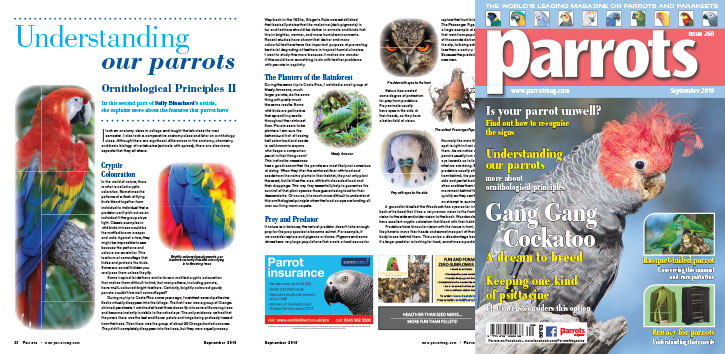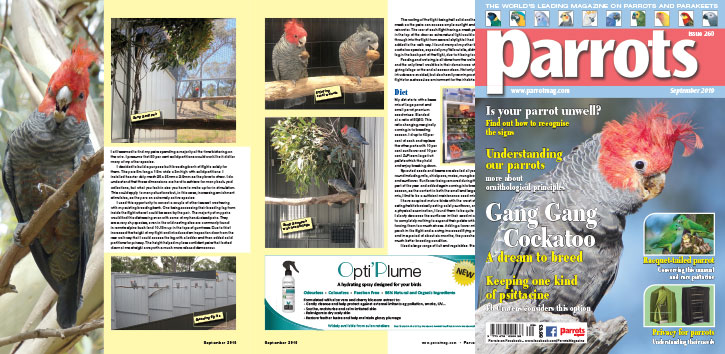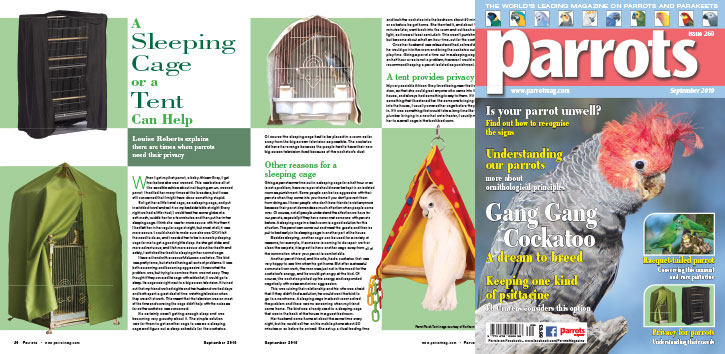
Complete Psittacine by Eb Cravens
I have always admired those bird keepers who only own one bird. They do not sell birds or reproduce birds or collect birds. They acquired a cage bird out of pure fascination with winged creatures and are totally satisfied to lavish all their daily care and attentions upon that one. For them cockatoos or conures or finches or canaries never became a habit.
That reminds me of a time some years ago when a group of friends were having a friendly discussion at an international avicultural convention. The question was asked if we could only have one kind of parrot, which kind would it be? There were few, if any, clear cut answers. “Oh, I could never decide,” was a common response. During the ensuing weeks, I continued to ponder this question. What a great way to focus all one’s bird keeping energies by choosing a single avian species and devoting all one’s energies to that type, with an avicultural flock, or a single breeding pair, or keeping a single pet or two of that chosen species as companions in the home.
It bears mention that the opposite of this method of bird keeping is the indiscriminate buying and collecting of one parrot after another of many different species, making it difficult to closely monitor and gather relevant information about each single type involved. The educational value of a single species flock I call it.
Buy Now!

By Sally Blanchard
I took an anatomy class in college and taught the lab class the next semester. I also took a comparative anatomy class and later an ornithology class. Although there are significant differences in the anatomy, chemistry, and basic biology of vertebrates (animals with spines), there are also many aspects that they all share.
In the world of nature, there is what is called cryptic coloration. Sometimes the patterns of a flock of flying birds blend together from individual to individual that a predator can’t pick out as an individual if the group stays tight. Classic examples in wild birds in trees would be the mottled brown creeper and owls. Against a tree, they might be impossible to see because the patterns and colours are so similar. This is a form of camouflage that hides and protects the birds. Some are so well hidden you rarely see them unless they fly.
Some tropical birds have similar brown mottled cryptic colouration that makes them difficult to find, but many others, including parrots, have multi-coloured bright feathers. Certainly, brightly coloured gaudy parrots couldn’t be well camouflaged?
Buy Now!

By Scott Breckenridge
The Gang Gang Cockatoo (Callocephalon Fimbriatum) is the smallest of the black cockatoo family. The name coming from a language spoken by the native Wiradjuri people, a group of Indigenous Australian Aboriginals from the central coast of New South Wales. The Gang Gang is found in the south-eastern states of Australia from New South Wales, Australian Capital Territory down to Victoria and further around to South Australia. Commonly residing in cooler wetter forests and woodlands particularly alpine bush land.
The Gang Gang is a mini black cockatoo. Measuring in at an average of 34cm from the top of its head to the tip of its short tail with an adult weight of around 230grams. Predominately a dark grey coloured bird with lighter grey and white scalloping over the feather tips. Crowned with a tuft of fairy floss-like feathers. The cock bird’s crest and head are red in colour with a greenish tinge visible on the wing converts. Whereas in females the crest and head remains grey, but from the neck down, over the chest to the vent, has an orangey yellow subtle barring. Their mandibles are ivory in colour. Juvenile birds can often be mistaken for females. In some cases, the cock birds will feather up first with mostly all red adult plumage achieved completely by three years of age. Their voice is raspy gremlin-like chatter magnified in intensity to sound off intruders.
Buy Now!

Louise Roberts explains there are times when parrots need their privacy
When I got my first parrot, a baby African Grey, I got her before she was weaned. This was before all of the sensible advice about not buying an un-weaned parrot. I had fed her many times at the breeders, but I was still concerned that I might have done something stupid.
So I got her a little travel cage, as a sleeping cage, and put in a folded towel and set it on my bedside table at night. Every night we had a little ritual, I would feed her some globs of a soft mash, cuddle her for a few minutes and then put her in her sleeping cage. I think she was far more secure with this than if I had left her in her regular cage at night, but most of all, it was more secure. I could check to make sure she was OK if I felt the need to do so, and I needed her to be in a nearby sleeping cage for me to get a good night’s sleep. As she got older and more adventurous, and I felt more secure about her health and safety, I switched her back to sleeping in her normal cage.
I have a friend with a rescue Moluccan cockatoo. The bird was pretty tame, but started having all sorts of problems. It was both screaming and becoming aggressive. I knew what the problem was, but trying to convince them was not easy. They thought if they covered its cage with a blanket, it would go to sleep. Its cage was right next to a big screen television. It turned out that my friend worked nights and her husband worked days and both spent a great deal of time watching television when they weren’t at work. This meant that the television was on most of the time and covering the cage didn’t help with the noise as far as the cockatoo was concerned.
Buy Now!




